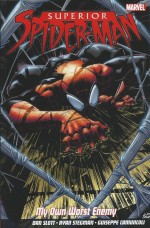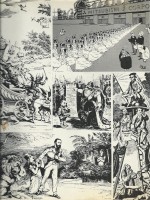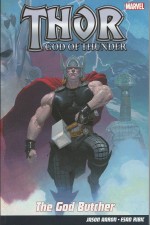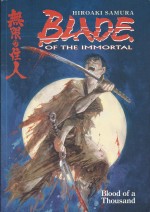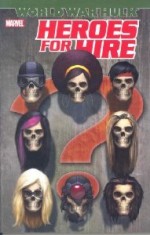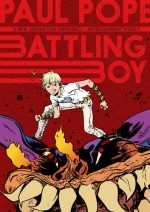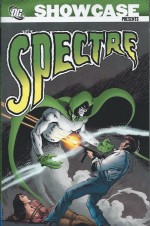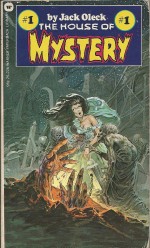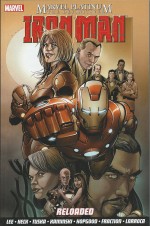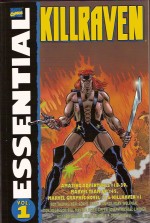
By Don McGregor & P. Craig Russell, Roy Thomas, Gerry Conway, Bill Mantlo, Neal Adams, Herb Trimpe, Gene Colan & various (Marvel)
ISBN: 978-0-7851-1777-3
When the first flush of the 1960s superhero revival began to fade at the end of the decade Marvel, who had built their own resurgent renaissance on the phenomenon, began desperately casting around for new concepts to sustain their hard-won impetus. The task was especially difficult as the co-architect of their success (and the greatest and most experienced ideas-man in comics) had jumped ship to arch-rival National/DC, where Jack’s Kirby’s battalion of Fourth World series, The Demon, Kamandi, Last Boy on Earth and other innovations were opening up new worlds of adventure to the ever-changing readership.
Although a global fascination with the supernatural had gripped the public – resulting in a huge outpouring of mystery and horror comics – other tried-and-true genre favourites were also revived and rebooted for modern sensibilities: westerns, war, humour, romance, sword & sorcery and science fiction…
At this time Stan Lee’s key assistant, star writer, ex-English teacher and lover of literature Roy Thomas was increasingly dictating the direction of Marvel: creating new concepts and securing properties that could given the “Marvel Treatmentâ€.
The policy had paid huge dividends with the creation of new titles Tomb of Dracula, Monster of Frankenstein and Werewolf by Night, whilst the brilliantly compelling Conan the Barbarian had quickly resulted in a whole new comicbook genus…
This compilation collects the bold and mercurial science-fiction thriller from Amazing Adventures #18-39, the saga’s nominal conclusion in Marvel Graphic Novel #7, a rare crossover appearance from Marvel Team-Up #45 and the 2001 Marvel Knights one-shot Killraven #1: an eclectic and admittedly inconsistent hero-history that has at times been Marvel’s absolute best and strong contender for worst character, in a sporadic career that spanned May 1973 to 1983 with occasional revivals and near-conclusions ever since.
The feature struggled for a long time to carve out a solid identity for itself, but finally found a brilliantly effective and fantastically poetic voice when scripter Don McGregor arrived – and stayed – slowly recreating the potential epic into a perfectly crafted examination of contemporary American society in crisis; proving the old adage that all science fiction is about the Present and not the Future….
He was ideally complimented in his task by fellow artisan P. Craig Russell whose beautifully raw yet idealised art matured page by page over the long, hard months he illustrated the author’s increasingly powerful and evocative scripts.
The dystopian tomorrow first dawned in Amazing Adventures #18, conceived by Thomas & Neal Adams, but scripted by Gerry Conway, wherein a ‘Prologue: 2018 A.D.’ introduced a New York City devastated by invasion and overrun by mutants, monsters and cyborgs all scavenging for survival. The creative process was a very troubled one. Adams left the project in the middle of illustrating the debut episode, leaving Howard Chaykin & Frank Chiaramonte to finish the tale of how a refugee mother lost her life defending her two boys from terrifying alien Tripods and vile human turncoats who had early switched allegiance to their revolting, human-eating new masters…
Young warrior and escaped gladiator Killraven then overcame all odds to kill a monstrous genetic manipulator dubbed the Keeper and save his brother Joshua, only to discover his sibling long gone and his despised tormentor grateful for death.
The elderly scientist had been compelled to perform many mutagenic experiments for his alien masters but had secretly enacted a Machiavellian double-cross, creating hidden powers in Jonathan Raven which might eventually overthrow the conquerors.
All the boy had to do was survive their horrific arena games until he was old enough to rebel against the Martians who had occupied Earth since 2001…
With his dying breath, Keeper provided his uneducated murderer with the history of ‘The War of the Worlds!’: of Free Mankind’s furious futile, atomic last stand and how the conquerors had possessed the shattered remnant of Earth…
He reveals how his gladiatorial training and scientific abuses shaped Killraven into the perfect tool of liberation and retribution, even to the warrior’s recent escape and first attempts at raising a resistance movement…
However just as the story ends the liberator realises he has tarried too long as mutant monsters close in…
The adventure resumed in #19 as the rebel narrowly escaped the psionic snares of ‘The Sirens of 7th Avenue’ (Conway, Chaykin & Frank McLaughlin) and the myriad terrors of the devastated metropolis to link up with second-in-command M’Shulla and strike a heavy blow against the alien butchers by destroying two hulking mechanical Tripods.
Newly elevated to the status of genuine threat to the conquerors, the rebels planned a raid on a New Jersey base but were instead captured by the mesmerising Skarlet, Queen of the Sirens, who handed them over to the Martian in charge of the city…
Forced to fight a mutated monstrosity in the alien’s private arena, Killraven unexpectedly turned the tables and drove off the gelatinous horror before boldly declaring that he was the guardian of Mankind’s heritage and would make Earth free again…
Amazing Adventures #20 was written by Marv Wolfman, with Herb Trimpe & Frank Giacoia illustrating ‘The Warlord Strikes!’, wherein the Freemen raided a museum and acquired weapons and armaments even as Killraven got himself a new look.
Easily defeating the traitorous lackeys of the Martian Masters the rebels were blithely unaware that the carnivorous extraterrestrial devils were deploying their latest tool: a cruelly augmented old enemy who hunted them down and easily overcame their primitive guns, swords and cross bows with his own onboard cyborg arsenal…
The ambitious series was already floundering and dearly needed a firm direction and steady creative hands, so it’s lucky that the concluding chapter in #21 (November 1973) saw the debut of Don F. McGregor, a young ambitious and lyrically experimental writer who slowly brought depth of character and plot cohesiveness to a strip which had reached uncanny levels of cliché in only three issues.
With Trimpe & “Yolande Pijcke†illustrating, ‘The Mutant Slayers!’ began the necessary task of re-establishing the oppressive, hopeless, all-pervasive horror and loss of Well’s original novel.
Determined to translate the concept into modern terms for the new generation of intellectual, comics-reading social insurgent, McGregor also took the opportunity to introduce the first of a string of complex, controversial and, above all, powerful female characters into the mix…
Carmilla Frost was a feisty, sharp-tongued geneticist and molecular biologist ostensibly faithful to her Martian masters, but she took the earliest opportunity to betray their local human lieutenant and help Killraven and the Freemen escape the brutal clutches of the Warlord.
For her own closely-guarded reasons, she and her bizarrely devoted monster anthropoid Grok the Clonal Man then joined the roving revolutionaries in their quest across the shattered continent…
In issue #22 (illustrated by Trimpe & Chiaramonte), the motley crew arrived in the former capital and encountered a ‘Washington Nightmare!’ After defeating a band of slavers led by charismatic bravo Sabre, Killraven formed an uneasy alliance with local rebel leader Mint Julep and her exclusively female band of freedom-fighters.
The green-skinned warrior woman had also battled Sabre and cautiously welcomed Killraven’s offer of assistance to rescue her captured comrades from the literal meat-market of the Lincoln Memorial, where flesh-peddling mutant horror Abraxas auctioned tasty human morsels to extraterrestrial patrons.
The raid went badly however, and it was Killraven himself who ended up on the conquerors’ menu in ‘The Legend Assassins!’ wherein the newly liberated resistance fighters united in a last-ditch attempt to save their tempestuous leader from the High Overlord.
Killraven, meanwhile, found himself main course in a public propaganda-feeding/execution, about to be devoured by a debased vermin-controlling freak named Rattack…
The hero’s faithful followers – including gentle, simple strongman Old Skull and embittered Native American Hawk – arrived just in time to join the furious fray in #24’s spectacular ‘For He’s a Jolly Dead Rebel’ (inked by Jack Abel) but their escape was only temporary and they were quickly recaptured.
However their example impressed more than one disaffected collaborator. When former foes led by Sabre united in battle against the Martian Overlord, the result was a shattering defeat for the once-unbeatable oppressors…
Amazing Adventures #25 introduced a returning nemesis for the charismatic rebel and his freedom fighters in ‘The Devil’s Marauder’ (art by Rich Buckler & Klaus Janson), as Killraven inconclusively clashed with Cyclopian Martian flunky Skar. During the battle the hard-pressed human was unexpectedly gripped by a manifestation of hidden psychic power – granting him visions he could not comprehend…
Travelling across country the rebels had stumbled onto another forgotten glory of Mankind’s past in the state once dubbed Indiana. The race circuit of the Indianapolis 500 was now a testing-ground for new terror-tripods and thus a perfect target for sabotage. However, when the fury-filled Killraven tackled human-collaborators and the sinister Skar returned, the incensed insurgent stepped too far over ‘The Vengeance Threshold!’…
In issue #26 Gene Colan & Dan Adkins illustrated ‘Something Worth Dying For!’ as the Freemen reached Battle Creek, Michigan where the Rebel Rouser encountered a feral snake/horse hybrid that he simply had to possess before the band was ambushed by human outlaws guarding a fabulous ancient treasure at the behest of petty tyrant Pstun-Rage the Vigilant…
As the place had once been the site of America’s breakfast cereal empire and this wry yarn is filled with oblique in-jokes – many of the villains’ names are anagrams of Kellogg’s cereals – you can imagine the irony-drenched secret of the hoard the defenders gave their lives to protect and the pragmatic Killraven’s reaction to it…
The drama kicked into spectacular high gear in Amazing Adventures #27 with the arrival of Craig Russell (inked by Jack Abel) and the start of a dark epic entitled ‘The Death Breeders’.
Whilst crossing frozen Lake Michigan in March 2019, the band was attacked by monstrous lampreys and Grok suffered a wound which would eventually prove fatal…
McGregor always hated the notion of simplistic, problem-solving, consequence-free violence which most entertainment media thrived on and frequently, slavishly, tried to focus on some of the real-world repercussions such acts should and would result in…
The heroes were headed to what was once Chicago; now a vast industrialised breeding pen to farm human babies for Martian consumption. En route they met pyrokinetic mutant Volcana Ash who had her own tragic reason for scouting the ghastly palaces of Death-birth…
Whilst the new allies undertook an explosively expensive sortie against the Death Breeders, at the same time in the far-distant halls of the Martian Kings of Earth, the Warlord was tasking the recovered, repaired Skar with a new mission: hunt down Killraven and destroy not only the man, but most importantly the legend of hope and liberation that had grown up around him…
In #28 (pencilled, inked and even coloured by Russell in the original) Ash revealed her horrific origins and the purpose of her quest as the Freemen battled monsters which abounded in the chemically compromised lake.
Elsewhere, chief butcher The Sacrificer watched his depraved boss Atalon live up to his decadent reputation as ‘The Death Merchant!’ – emotionally tenderising the frantic “Adams and Eves†whose imminent newborns would be the main course for visiting Martian dignitaries…
Everything changed during Killraven’s fateful raid to liberate the human cattle, however. When the disgusted hero skewered one of the extraterrestrial horrors, he experienced severe psychic feedback and realised at last that his debilitating, disorienting visions had been an unsuspected ability to tap into Martian minds…
And in the wastelands, Skar was murderously retracing the Freemen’s route, getting closer and closer to a final showdown…
With Amazing Adventures #29 the series title was changed to Killraven: Warrior of the Worlds as ‘The Hell Destroyers’ saw the rebel leader score his greatest victory, inspiring thousands of freshly-liberated earthlings by utterly destroying the temple of atrocity before gloriously escaping into the wilderness and modern mythology…
The pace of even a bi-monthly series was crippling to perfectionist Russell, and ‘The Rebels of January and Beyond!’ in #30 was a frantic six-page melange from him, Adkins, Trimpe, Chiaramonte & Abel, all graphically treading water as The Warlord “reviewed†(admittedly beautiful) fact-file pages on Killraven, M’Shulla and Mint Julep.
The saga continued in #31 on ‘The Day the Monuments Shattered’ wherein McGregor & Russell ended the Death Breeders storyline in stunning style. Pursued by Atalon and The Sacrificer into the icy wilds from Gary, Indiana to St. Louis where broken Earth outcasts hid as the Twilight People, the fugitives took refuge in a cavern. This was to allow an accompanying Eve to give birth in safety, but only led to an attack by a monolithic mutant monster just as their pursuers found them.
The battle changed the landscape and ended three ghastly travesties forever…
In #32 ‘Only the Computer Shows Me Any Respect!’ (art by Russell & Dan Green) found the reduced band in devastated Nashville, where Killraven, M’Shulla, Carmilla, Old Skull and Hawk wandered into leftover holographic fantasy programs which conjured both joy and regret, even as Skar’s tripod brought him ever-closer to a longed-for rematch.
Things took a nasty turn when Hawk’s painful memories of his father’s addictions to fantasy detective Hodiah Twist manifested as cruelly real threats and the malfunctioning program materialised a brutally solid savage dragon…
Issue #33 was another deadline-busting fill-in. ‘Sing Out Loudly… Death!’ was written by Bill Mantlo and illustrated by Trimpe & D. Bruce Berry, wherein the Freemen took refuge from the elements in a vast cave and encountered a hostile tribe of refugee African Americans who had gone native and returned to their roots.
The hidden wild men had only one rule – kill all honkies – but that changed once Killraven saved them from a marauding giant octo-beastie…
The long-delayed clash with Skar at last occurred in #34 as the cyborg Cyclops ambushed the wanderers when they reached Chattanooga, Tennessee and caused ‘A Death in the Family’ (McGregor & Russell) – two deaths, actually – before the heartbroken, enraged Warrior of the Worlds literally tore his gloating nemesis to pieces…
Killraven fully entered Marvel Universe continuity – albeit on a branch line – with a crossover appearance by Spider-Man: courtesy of a time-and-space spanning multi-parter in Marvel Team-Up which saw the Amazing Arachnid lost and visiting the past and a number of alternate tomorrows.
From issue #45 ‘Future: Shock!’ by Mantlo, Sal Buscema & Mike Esposito saw the weary Wallcrawler wash up in this particular furious future just as Killraven was cornered by killer tripods, and offer arachnid assistance as the liberators stumbled into an hallucinogenic nightmare. Immediate problem solved, the chronologically adrift Arachnid continued his time-tossed travels…
Amazing Adventures #35 resumed the epic tragedy as the last battered survivors stumbled into Atlanta, Georgia and met ‘The 24-Hour Man’ (McGregor & Russell, but finished by Keith Giffin & Abel), encountering an addled new mother and instant widow, even as Carmilla was abducted by a bizarre mutant with an irresistible and inescapably urgent biological imperative…
‘Red Dust Legacy’ (illustrated by Russell & Sonny Trinidad in #36) focused on Killraven’s developing psychic powers as the charismatic champion gained unwelcome insights into the Martian psyche, even as The Warlord travelled to Yellowstone and taunted the rebel leader with news that his long-lost brother Joshua lived. The hero had no idea it was as an indoctrinated pawn code-named Death Raven.
The self-appointed defender of humanity then invaded a replica Martian environment in Georgia and destroyed the Martians’ next generation by contaminating their incubators…
Inked by Abel, #37 revealed the origins of affable Old Skull in ‘Arena Kill!’ when the wanderers discovered a clandestine enclave of humans in the Okefenokee Wildlife Preserve.
One final fill-in by Mantlo, Giffin & Al Milgrom appeared in #38. ‘Death’s Dark Dreamer!’ saw Killraven separated and stumble into a wrecked but still functional dream-dome to battle the materialised fantasies of its ancient occupant, whose pre-invasion memories fuelled attacks by strangely familiar defenders patterned after Iron Man, Man-Thing, Dr. Strange and almost every other hero you could think of…
The beautiful, troubled and doomed saga stopped – but did not end – with Amazing Adventures #39 (November 1976) as McGregor & Russell introduced the decimated Band of Brothers to an incredible new life-form in ‘Mourning Prey’…
And that’s where the gloriously unique, elegiac, Art Nouveau fantasy vanished with no comfortable resolution until 1983 when Marvel Graphic Novel #7 featured an all-new collaboration by McGregor and Russell starring Killraven: Warrior of the Worlds.
That painted full-colour extravaganza is reproduced here and commences after a catch-up Prologue and six pages of character profiles to bring readers old and new up to speed…
‘Last Dreams Broken’ opens in February 2020 at Cape Canaveral where Killraven connects again to a distant consciousness and sets off for Yellowstone in search of answers to inexpressible questions…
Along the way the rebels meet 59-year old Jenette Miller – probably the last surviving astronaut on Earth – as ‘Cocoa Beach Blues’ finds her teaching the warrior wanderers some history and human perspective in between the constant daily battles, whilst in ‘Blood and Passion’ The Warlord prepares his deadliest trap for his despised antagonist as Killraven is finally reunited with Joshua.
The drama runs its inevitable course in ‘Let it Die Like Fourth of July’ as all the hero’s hopes and fears are cataclysmically realised…
McGregor’s long-anticipated conclusion did not disappoint and even set up a new beginning, but in this monochrome edition Russell’s stunning colour artwork suffers egregiously from being reduced to greyscale tones, and if you get the chance to see the original Graphic Novel version, grab it and run…
Those same artistic mixed results plague the last tale in this tome too.
In 2001 the Marvel Knights imprint offered another revival as Killraven #1, written and painted by Joseph Michael Linsner with Eva Hopkins, saw the Warrior of the Worlds back in New York as ‘Killraven: 2020’, fleeing tripods and stumbling into an untouched alcove where a flower-child from 1976 lay preserved in a hibernation-chamber.
Alice and two dozen happy young liberals thought to sleep their way out of the pollution, violence and corruption of those unhappy times, but as the only survivor she found the future far from what she had expected.
The unhappy Hippy did have some life-changing advice and insights for the crazy war-monger who rescued her, though…
Also included here is the text introduction page from Amazing Adventures #18 for a fascinating insight into Roy Thomas’ expectations of what became a landmark of visual narrative poetry that was far beyond its time and mass audience’s taste.
Confused, convoluted, challenging, controversial (this series contained the first ever non-comedic interracial kiss in American comics – in 1975 if you can believe it!), evocative, inspirational and always entertaining, this is graphic narrative that no serious fan or fantasy addict should miss. Do it now: the future is not your friend…
© 1973, 1974, 1975, 1976, 1983, 2001, 2005 Marvel Characters, Inc. All rights reserved.
